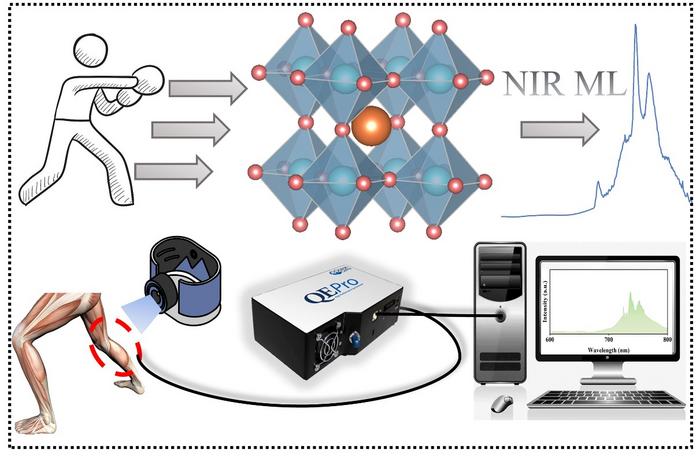Mechanoluminescence (ML) located within the near infrared (NIR) spectral range may have hold promising applications in in-situ and real-time biomechanical imaging. This is due to the better spatial resolution and penetration depth of the biological tissues, lower optical loss and the avoidance of autofluorescence. Historically, rare earth ions have been predominantly employed as activators in ML materials. However, adjusting the emissions of rare earth ions, especially RE3+, poses challenges, thereby limiting the practical application of NIR MLs. Therefore, the transition metal ions activated systems have been favored by more and more researchers.

Credit: Peishan Shao, et al
Mechanoluminescence (ML) located within the near infrared (NIR) spectral range may have hold promising applications in in-situ and real-time biomechanical imaging. This is due to the better spatial resolution and penetration depth of the biological tissues, lower optical loss and the avoidance of autofluorescence. Historically, rare earth ions have been predominantly employed as activators in ML materials. However, adjusting the emissions of rare earth ions, especially RE3+, poses challenges, thereby limiting the practical application of NIR MLs. Therefore, the transition metal ions activated systems have been favored by more and more researchers.
Previously, Puxian Xiong and colleagues have reported a self-recoverable NIR ML material in gallate by using Cr3+ ions as the emission center for the first time.
“Indeed, LiGa5O8:Cr3+ presents good ML repeatability and does not require pre-irradiation process, but the intrinsic ML mechanisms are still not entirely clear,” says Xiong. “In particular, whether the remanent carriers occupied lattice traps can affect the ML repeatability is unclear.”
As is generally known, the preheating method is one of the most effective ways to remove the remanent carriers. In a new study published in Advanced Powder Materials, the team integrated the preheating method with corresponding ML results. “This work intends for actualizing the analysis of the ML mechanism through eliminating the influences of stored carriers,” shares Xiong, who serves as co-corresponding author of the study.
In all, Cr3+ ions doped perovskite-type LaAlO3 ML phosphor is successfully synthesized by a traditional high-temperature solid-sate reaction method in air. Combined with photoluminescence, persistent luminescence, diffuse reflectance and thermoluminescence characterizations, the inherent ML mechanism was discussed in detail by the authors.
“We observed that ML in LaAlO3: Cr3+ is self-recoverable, which is obviously different from the trap-controlled ML compounds (requiring UV light for pre-irradiation). Based on the preheating method and corresponding ML analysis, such self-recoverable ML depends more on the piezoelectricity of the non-centrosymmetric LaAlO3: Cr3+,” shares Xiong.
Under mechanical stimuli, a strong piezoelectric field is built within the compound, which is large enough to generate electronically excited states of the Cr3+ ions, subsequently resulting in ML. This luminescence is featured with self-recoverability, implying that the compound can be applied to different applications.
“We further demonstrated great potential application prospects for the ML Bioimaging, anti-counterfeiting and information encryption field with the encoding and decoding of ASCII code,” adds Xiong.
###
Contact the author: Puxian Xiong; State Key Laboratory of Luminescent Materials and Devices, School of Materials Science and Engineering, School of Physics and Optoelectronics, Guangdong Provincial Key Laboratory of Fiber Laser Materials and Applied Techniques, Guangdong Engineering Technology Research and Development Center of Special Optical Fiber Materials and Devices, South China University of Technology, Guangzhou 510641, China; [email protected].
The publisher KeAi was established by Elsevier and China Science Publishing & Media Ltd to unfold quality research globally. In 2013, our focus shifted to open access publishing. We now proudly publish more than 100 world-class, open access, English language journals, spanning all scientific disciplines. Many of these are titles we publish in partnership with prestigious societies and academic institutions, such as the National Natural Science Foundation of China (NSFC).
Journal
Advanced Powder Materials
DOI
10.1016/j.apmate.2023.100165
Method of Research
Experimental study
Subject of Research
Not applicable
Article Title
Self-recoverable NIR mechanoluminescence from Cr³⁺ doped perovskite type aluminate
COI Statement
The authors declare that they have no known competing financial interests or personal relationships that could have appeared to influence.




